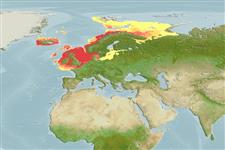Klassifizierung / Names
Namen | Synonyme | Catalog of Fishes (gen., sp.) | ITIS | CoL | WoRMS | Cloffa
Actinopterygii (Strahlenflosser) >
Scorpaeniformes (Scorpionfishes and flatheads) >
Liparidae (Snailfishes)
Etymology: Liparis: Greek, liparos = fat (Ref. 45335).
Lebensraum / Klimazone / Range
Ökologie
; seewasser demersal; tiefenbereich 1 - 300 m (Ref. 35388). Temperate, preferred ?; 81°N - 48°N, 25°W - 62°E
Northeast Atlantic: southern Norway north to Barents Sea including Novaya Zemlya, Spitsbergen and Bear Island, also Iceland.
Size / Gewicht / Alter
Maturity: Lm ? range ? - ? cm
Max length : 15.0 cm TL Männchen/unbestimmt; (Ref. 4645)
Kurzbeschreibung
Morphologie | Morphometrie
Suction disc much larger than the eye diameter. Dorsal and anal fins overlap with the caudal fin. Two nostrils on each side of the snout (Ref. 35388).
Occurs from the subtidal zone to less than 300 m (Ref. 4702). Feeds primarily on crustaceans, occasionally fishes and polychaetes (Ref. 4702). Spawns in the winter (Ref. 35388).
Life cycle and mating behavior
Geschlechtsreife | Fortpflanzung | Ablaichen | Eier | Fecundity | Larven
Perlmutter, A., 1961. Guide to marine fishes. Bramhall House, New York. 431 p. (Ref. 169)
IUCN Rote Liste Status (Ref. 115185)
CITES (Ref. 94142)
Not Evaluated
Bedrohung für Menschen
Harmless
Nutzung durch Menschen
Tools
Zusatzinformationen
Download XML
Internet Quellen
Estimates of some properties based on models
Phylogenetic diversity index (Ref.
82805): PD
50 = 0.5000 [Uniqueness, from 0.5 = low to 2.0 = high].
Trophic Level (Ref.
69278): 3.6 ±0.58 se; Based on food items.
Widerstandsfähigkeit (Ref.
69278): hoch, Verdopplung der Population dauert weniger als 15 Monate. (Preliminary K or Fecundity.).
Verwundbarkeit (Ref.
59153): Low vulnerability (21 of 100) .
